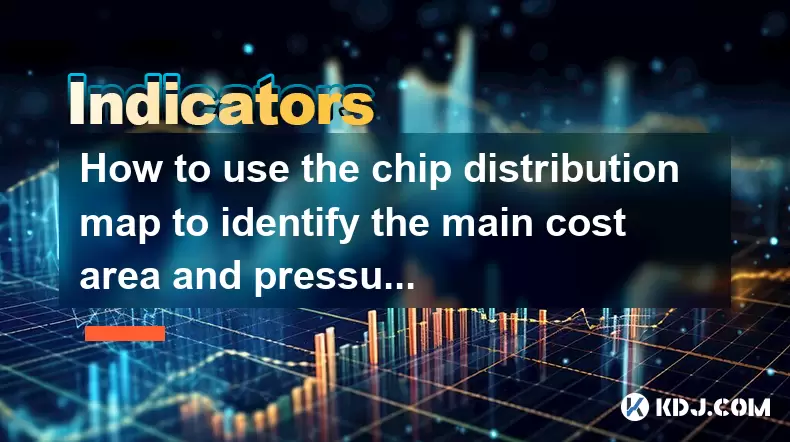-
 Bitcoin
Bitcoin $117500
0.67% -
 Ethereum
Ethereum $3741
2.96% -
 XRP
XRP $3.146
2.08% -
 Tether USDt
Tether USDt $1.000
0.00% -
 BNB
BNB $784.1
3.05% -
 Solana
Solana $186.5
3.62% -
 USDC
USDC $1.000
0.01% -
 Dogecoin
Dogecoin $0.2368
4.76% -
 TRON
TRON $0.3171
1.52% -
 Cardano
Cardano $0.8237
3.17% -
 Hyperliquid
Hyperliquid $44.25
6.78% -
 Sui
Sui $3.976
9.51% -
 Stellar
Stellar $0.4376
4.71% -
 Chainlink
Chainlink $18.38
5.19% -
 Hedera
Hedera $0.2674
12.93% -
 Bitcoin Cash
Bitcoin Cash $557.2
6.43% -
 Avalanche
Avalanche $24.07
3.40% -
 Litecoin
Litecoin $112.9
2.98% -
 UNUS SED LEO
UNUS SED LEO $8.992
0.13% -
 Shiba Inu
Shiba Inu $0.00001404
5.34% -
 Toncoin
Toncoin $3.213
4.32% -
 Ethena USDe
Ethena USDe $1.001
-0.02% -
 Uniswap
Uniswap $10.50
6.55% -
 Polkadot
Polkadot $4.113
4.42% -
 Monero
Monero $324.9
-1.54% -
 Dai
Dai $1.000
0.00% -
 Bitget Token
Bitget Token $4.572
0.95% -
 Pepe
Pepe $0.00001261
5.80% -
 Aave
Aave $297.6
4.75% -
 Cronos
Cronos $0.1323
4.84%
如何使用芯片分配图来确定主要成本领域和压力支持水平?
芯片分销图可帮助交易者确定关键价格水平购买的位置,以帮助设定战略入境和加密货币交易的退出点。
2025/06/09 23:00

在加密货币交易的世界中,了解各种价格水平的芯片(或令牌)的分布对于做出明智的决定至关重要。芯片分配图是一个强大的工具,可帮助交易者确定主要成本领域和压力支持水平。通过分析这张地图,交易者可以深入了解大多数令牌的购买以及可能发生巨大买卖压力的地方。本文将深入研究如何有效地使用芯片分配图来查明这些关键领域。
了解芯片分配图
芯片分配图是以不同价格水平持有的令牌数量的视觉表示。它显示了每个价格点购买了多少个令牌,并清楚地了解了投资者之间成本分配的情况。该地图对于确定主要成本领域至关重要,这是购买最大代币的价格水平,以及压力支持水平,这表明可能出现重大买卖压力。
确定主要成本领域
要使用芯片分配图确定主要成本区域,请按照以下步骤:
- 访问芯片分发图:首先访问首选交易平台上的芯片发行图。大多数信誉良好的平台在其分析部分提供了此工具。
- 分析峰:查找地图上的最高峰。该峰代表购买最多的代币的价格水平。这是您的主要成本领域。
- 考虑体积:注意此峰值的令牌量。较高的体积表明在此价格水平上的支持或阻力更强。
- 使用历史数据确认:交叉引用的主要成本区域具有历史价格数据,以确认其意义。如果价格从历史上偏离了这一水平,则可以增强其重要性。
识别压力支持水平
压力支持水平是可能发生重大买卖压力的关键点。要识别这些级别,请按照以下步骤:
- 确定多个峰:除了主要成本区域,还要在芯片分配图上寻找其他重要峰。这些代表了购买大量令牌的其他级别。
- 评估密度:评估这些峰处的令牌密度。较高的密度表明潜在的支持或抵抗力更强。
- 结合市场趋势:考虑当前的市场趋势和情感。如果市场是看好的,那么较低的压力支持水平可能更相关,而在看跌市场中,较高的水平可能会发挥作用。
- 使用技术指标:将芯片分配图与诸如移动平均或RSI之类的技术指标结合在一起,以验证已确定的压力支持水平。
在交易中应用芯片分销图
一旦使用芯片分销图确定了主要成本领域和压力支持水平,就可以将此知识应用于交易策略:
- 进入和出口点:使用主要成本区域作为设置和出口点的参考。如果价格接近这个水平,则可能是进入或退出职位的好时机,具体取决于您的分析。
- 停止损失和分支机构级别:设置停止损失订单,略低于主要成本领域,以保护您的投资。同样,将额外加油水平设置在确定的压力支持水平附近,以利用潜在的价格变动。
- 位置尺寸:根据主要成本区域的强度和压力支持水平调整位置大小。更强大的水平可能需要更大的立场,而较弱的水平表明更保守的尺寸。
与其他分析工具集成
虽然芯片分销图本身就是一个强大的工具,但将其与其他分析工具集成可以增强其有效性:
- 音量配置文件:将芯片分布图与音量配置文件结合在一起,以更全面地了解最多的交易活动。这可以帮助确认主要成本领域和压力支持水平。
- 订单簿数据:分析订单簿,以查看大型买卖订单的位置。这可以为潜在压力支持水平提供更多的见解。
- 情感分析:使用情感分析工具来衡量市场情绪。积极的情绪可能会增强确定的支持水平的力量,而负面情绪可能表明潜在的崩溃。
实际示例:使用芯片分配图
让我们浏览一个实用的例子,以说明如何使用芯片分配图来确定主要成本领域和压力支持水平:
- 访问地图:打开交易平台,并导航到您正在分析的加密货币的芯片分发图,例如Bitcoin。
- 确定主要成本区域:在地图上,您注意到30,000美元的高峰,表明以这个价格购买了大量Bitcoin。这是您的主要成本领域。
- 确定压力支持水平:您观察到另一个峰值为25,000美元,这表明购买了许多令牌的次要水平。这可能是压力支持水平。
- 分析数量:30,000美元的数量明显高于其他级别,从而增强了其作为主要成本领域的重要性。
- 使用历史数据确认:您检查历史数据并发现价格已经弹出了30,000美元,确认其作为强大的支持水平的作用。
- 适用于交易:根据此分析,您决定将购买订单设置在30,000美元附近,预计会反弹。您将停止损坏设置为$ 25,000,即确定的压力支持水平,以保护您的投资。
常见问题
问:所有加密货币都可以使用芯片分配图吗?
答:是的,芯片分发图可用于任何具有足够交易量和数据的加密货币。但是,地图的准确性和实用性可能会根据加密货币的流动性和市场深度而有所不同。
问:我应该使用芯片分发图更新一次分析?
答:建议使用芯片分销图定期更新分析,尤其是在重大的价格变动期间或新的市场数据可用时。每日或每周更新可以帮助您了解主成本领域和压力支持水平的变化。
问:使用芯片分配图有什么局限性吗?
答:是的,芯片分发图有一些局限性。它依靠历史数据,可能不会说明可能影响价格变动的突然市场转移或外部因素。此外,地图的准确性取决于交易平台提供的数据的质量和完整性。
问:芯片分销图可以与其他交易策略一起使用吗?
答:绝对。芯片分销图可以与各种交易策略集成,例如趋势跟随,平均归还或动量交易。通过将芯片分销图的见解与其他策略相结合,交易者可以增强其决策过程并提高其整体交易绩效。
免责声明:info@kdj.com
所提供的信息并非交易建议。根据本文提供的信息进行的任何投资,kdj.com不承担任何责任。加密货币具有高波动性,强烈建议您深入研究后,谨慎投资!
如您认为本网站上使用的内容侵犯了您的版权,请立即联系我们(info@kdj.com),我们将及时删除。
- 虚拟每周下降:恢复分析和隐私推动
- 2025-07-26 08:50:11
- 比特币,辛西娅·卢米斯(Cynthia Lummis)和自由金钱:纽约人
- 2025-07-26 08:30:11
- 加密货币,前十名,第30周:山寨币趋势趋势
- 2025-07-26 08:55:12
- Solana,Altcoins和Coinbase:什么是嗡嗡声?
- 2025-07-26 06:30:12
- 2025年的XRP:公牛跑还是胸围?
- 2025-07-26 07:30:12
- Ruvi AI预售升温:早期投资者注视着巨大的收益
- 2025-07-26 09:10:13
相关百科

这意味着在第一次以短位置安排移动平均线后,篮板被阻塞?
2025-07-26 10:51:10
了解短期移动平均配置当交易者在移动平均值中提到“短职位安排”时,他们描述了一种技术设置,其中较短的移动平均值低于长期的交叉。这种配置通常标志着看跌趋势。例如,当5周期移动平均线(MA)在10个周期MA以下和10个周期的MA以下时,已经以下是20个周期的MA时,据说移动平均值是按降序对齐的。这种对齐通...

当价格连续五天沿5天移动平均线上涨时,这意味着什么?
2025-07-26 08:07:37
了解加密货币交易中的5天移动平均值5天移动平均线(5DMA)是加密货币交易中广泛使用的技术指标,该指标计算过去五天资产的平均收盘价。贸易商使用此指标来平滑短期价格波动并确定基本趋势。当价格连续五天沿5天移动平均线上升时,这表明市场上的势头持续一致。这种模式表明,每天的收盘价不仅高于前一天的收盘价,而...

当价格突破了60天的移动平均水平,但第二天收缩是什么意思?
2025-07-26 06:01:03
了解加密货币交易中的60天移动平均60天的移动平均线(60DMA)是加密货币市场中广泛使用的技术指标,在过去60个交易日内平滑了价格数据。它通过滤除短期价格波动来帮助交易者确定整体趋势方向。当目前的价格高于60dma时,它通常标志着看涨的趋势,而低于下方的价格表明看跌势头。交易者会关注跨界车(当价格...

当Obv继续达到新高点但价格停滞时,这意味着什么?
2025-07-26 09:57:50
了解体积体积(明显)指标平衡量(OBP)是技术分析指标,该指标使用量流量来预测库存或加密货币价格的变化。由乔·格兰维尔(Joe Granville)开发的Obv在一个简单的前提下运行:数量先于价格变动。计算很简单 - 与上一时期相比,加密货币的收盘价上涨时,该期间的体积添加到累积的OBP中。相反,如...

EMA12和EMA26的黄金十字架是什么反映的?
2025-07-26 06:44:03
了解EMA12和EMA26中的黄金十字金十字是加密货币市场中广泛认可的技术指标,表明潜在的看涨逆转。当12个周期指数的移动平均值(EMA12)交叉以上26个周期指数移动平均值(EMA26)时,就会发生这种情况。这种模式通常被解释为短期势头超越长期动力的标志,表明买家正在获得控制。交易者使用此信号预测...

当价格突破30天的移动平均线并伴随着大量的含义是什么意思?
2025-07-26 03:35:37
了解加密货币交易中的30天移动平均30天移动平均线(MA)是加密货币市场中广泛使用的技术指标,该指标计算了过去30天的资产的平均收盘价。该指标将价格数据平滑以形成趋势范围的指标,从而帮助交易者确定价格转移的一般方向。当目前的价格高于30天的MA时,它通常标志着看涨趋势,而低于MA的价格可能表明看跌势...

这意味着在第一次以短位置安排移动平均线后,篮板被阻塞?
2025-07-26 10:51:10
了解短期移动平均配置当交易者在移动平均值中提到“短职位安排”时,他们描述了一种技术设置,其中较短的移动平均值低于长期的交叉。这种配置通常标志着看跌趋势。例如,当5周期移动平均线(MA)在10个周期MA以下和10个周期的MA以下时,已经以下是20个周期的MA时,据说移动平均值是按降序对齐的。这种对齐通...

当价格连续五天沿5天移动平均线上涨时,这意味着什么?
2025-07-26 08:07:37
了解加密货币交易中的5天移动平均值5天移动平均线(5DMA)是加密货币交易中广泛使用的技术指标,该指标计算过去五天资产的平均收盘价。贸易商使用此指标来平滑短期价格波动并确定基本趋势。当价格连续五天沿5天移动平均线上升时,这表明市场上的势头持续一致。这种模式表明,每天的收盘价不仅高于前一天的收盘价,而...

当价格突破了60天的移动平均水平,但第二天收缩是什么意思?
2025-07-26 06:01:03
了解加密货币交易中的60天移动平均60天的移动平均线(60DMA)是加密货币市场中广泛使用的技术指标,在过去60个交易日内平滑了价格数据。它通过滤除短期价格波动来帮助交易者确定整体趋势方向。当目前的价格高于60dma时,它通常标志着看涨的趋势,而低于下方的价格表明看跌势头。交易者会关注跨界车(当价格...

当Obv继续达到新高点但价格停滞时,这意味着什么?
2025-07-26 09:57:50
了解体积体积(明显)指标平衡量(OBP)是技术分析指标,该指标使用量流量来预测库存或加密货币价格的变化。由乔·格兰维尔(Joe Granville)开发的Obv在一个简单的前提下运行:数量先于价格变动。计算很简单 - 与上一时期相比,加密货币的收盘价上涨时,该期间的体积添加到累积的OBP中。相反,如...

EMA12和EMA26的黄金十字架是什么反映的?
2025-07-26 06:44:03
了解EMA12和EMA26中的黄金十字金十字是加密货币市场中广泛认可的技术指标,表明潜在的看涨逆转。当12个周期指数的移动平均值(EMA12)交叉以上26个周期指数移动平均值(EMA26)时,就会发生这种情况。这种模式通常被解释为短期势头超越长期动力的标志,表明买家正在获得控制。交易者使用此信号预测...

当价格突破30天的移动平均线并伴随着大量的含义是什么意思?
2025-07-26 03:35:37
了解加密货币交易中的30天移动平均30天移动平均线(MA)是加密货币市场中广泛使用的技术指标,该指标计算了过去30天的资产的平均收盘价。该指标将价格数据平滑以形成趋势范围的指标,从而帮助交易者确定价格转移的一般方向。当目前的价格高于30天的MA时,它通常标志着看涨趋势,而低于MA的价格可能表明看跌势...
查看所有文章

























































































